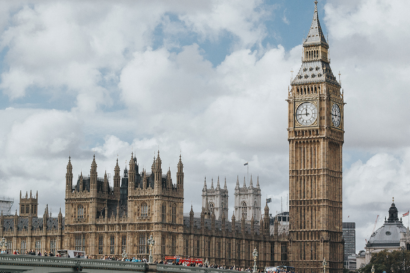AG INSIGHT | 05/08/2024
Reviving green and pleasant land: Biodiversity Net Gain and balancing developments

Aldersgate Group’s Membership Officer Jack Kunkle discusses the introduction and recent assessments of Biodiversity Net Gain, and considers how this policy could continue to develop. He also touches on the Dasgupta Review and ‘nature-fying’ finance.
In the 400 years since Shakespeare described England as ‘This other Eden, demi-paradise’, nature in England has seen a sharp and brutal decline. As anyone who watched BBC’s Wild Isles series will tell you, the UK is home to some of the planet’s most astonishing plants, animals and ecosystems; sandwiched between the Atlantic Ocean and mainland Europe, the UK is a vital haven for migratory birds and home to globally rare habitats like chalk streams and temperate rainforests. This ‘precious stone set in the silver sea’ is also one of the planet’s most nature depleted countries and will continue to decline unless urgent action is taken. One scheme recently introduced to help improve the state of nature alongside desperately needed housebuilding and development projects is Biodiversity Net Gain.
It has been a few months since Biodiversity Net Gain (BNG) came into full effect in England, applying to small developments with nine houses or fewer. Now most new developments, including housing and infrastructure projects, will have to leave nature in a better condition than they found it. If a woodland is cut down to make way for a new housing development or road, another equivalent woodland needs to be created plus a 10% boost. A system of ‘biodiversity units’ has been created using the UK Defra biodiversity metric 4.0, where a habitat’s size, type, and ecological condition is quantified and assigned a ‘unit’ – less for a grass lawn, more for a woodland. If the development cannot improve the number of units on a site, the developer will have to purchase more units from a landowner who has spare, creating a sort-of ‘nature market’. Eftec estimates this nature market will be worth around £200m per year. The policy represents one of the most ambitious schemes of its type globally, and the hope is that England can use its housing and infrastructure projects to improve on its dire ecological record.
In the same year that Philip Hammond, then Chancellor of the Exchequer, announced the first stages of Biodiversity Net Gain, he also commissioned the Dasgupta Review, a comprehensive global review into the link between biodiversity and economic growth. The Dasgupta Review, an expansive 600-page report, highlighted the global economy’s reliance on nature and the destructive tendencies of our economic activities. It was intended to be the north star resource for public policy makers looking to better include nature in their economic decision making. At its core, the Review called for a social, cultural and economic paradigm shift to recognise that our economies are embedded within nature, not external to it.
The introduction of BNG is a positive step forward, but more is required to deliver the recommendations of the Dasgupta Review. BNG will contribute to Government targets like 30by30, whereby the UK must protect and conserve 30% of its land and sea by 2030, and represents a powerful legislative piece in the environmental policy ecosystem in England. BNG also gives businesses a clear direction of travel and affords them the confidence to make long term investments in line with the conditions set out in law.
Eventually, BNG will sit alongside England’s Land Use Framework, a long promised but yet to be delivered framework, that should inform policy makers and landowners on how to balance competing priorities for England’s limited land. The Land Use Framework should act as a guide for what needs to be built and where, balancing the need for food production, housing and infrastructure, energy, industry, and nature. BNG has firmed up confidence for businesses to invest in nature restoration projects, and the Land Use Framework is poised to further bolster investor confidence.
The National Audit Office published a report in May on how the implementation of BNG has gone. The report was complimentary of BNG and Defra for rolling out a novel scheme under a tight deadline and within the parameters of an existing and complex planning system. That said, the report was critical of the scheme’s operational shortcomings, highlighting a concern that local authorities lack the means to effectively enforce the scheme coupled with the lack of involvement that Defra has in the affiliated biodiversity credit market. Without addressing these concerns, the NAO is concerned that BNG could actually work against efforts to increase biodiversity in England.
A broader criticism often lobbied at BNG and similar schemes is that they are ‘financialising nature’ and thereby reducing its rich complexity to cold-eyed algorithmic tinkering. By tying a financial figure to the value of a woodland, a stream, or an ancient Oak tree, the critics say, you are treating nature like a deck of trading cards – I’ll trade you two chalk streams for one of your ancient woodlands. The Dasgupta Review faced similar criticisms over its attempts to value biodiversity as it relates to the economy. It is true that nature cannot be financialised. Nature is fundamentally a different sort of thing to finance and cannot be broken down into neat quantitative, fungible packets. Professor Dasgupta’s rebuttal to those criticisms is that if we do not put a price on nature, however it is calculated, then its price will remain at zero. Without trying to incorporate the value of nature, including the ecosystem services it provides, a forest is only as valuable as the sum of its timber. But if you put a price on a living forest, as BNG does, suddenly the value of that forest is visible in economic decision making. In this sense, BNG and Dasgupta are not trying to financialise nature but instead ‘nature-fy’ finance. That’s the thinking, anyway.
Biodiversity Net Gain is a legislative lynchpin that is already helping to shift private finance into nature restoration and conservation in England. It is also a new foundational piece of England’s environmental policy ecosystem, building on past legislation and flexible enough that future legislation can be sewn in. As the Aldersgate Group’s recent report on the benefits of smart environmental regulation found, it is paramount that Government sets a clear direction of travel for businesses to invest in nature restoration, that sectors are working collaboratively to address cross-cutting and system-wide environmental issues, and that there needs to be a full assessment of societal costs and benefits when decisions are made. Biodiversity Net Gain addresses all of these issues, albeit with room for improvement.
One area to keep an eye on as BNG develops is how it assesses and values the cultural ecosystem services nature can provide; would the Sycamore Gap Tree have had more BNG units than a sycamore tree standing in another field? Should Hundred Acre Wood be valued higher for hosting Winnie the Pooh and friends? How do we value the priceless 1,100 year old Windsor Oak tree, potentially older than England itself? BNG does include special protections for ancient and veteran trees but I’m not sure that quite captures it.
Biodiversity Net Gain is a real, meaningful action that will increase nature in England. It is a piece of the puzzle that will eventually see the UK protect and conserve 30% of land and sea, and rebalance our economy and society’s relationship with nature. It can serve as a green shoot of optimism for wildlife, bringing us closer to Shakespeare’s depiction of ‘This blessed plot, this earth, this realm, this England’.
Next, get ready for Marine Net Gain…



